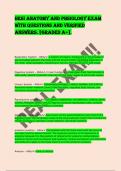HESI ANATOMY AND PHSIOLOGY EXAM
WITH QUESTIONS AND VERIFIED
ANSWERS. [GRADED A+].
Respiratory System - ANS✔✔-A system of organs, functioning in the process of
gas exchange between the body and the environment, consisting especially of
the nose, nasal passages, nasopharynx, larynx, trachea, bronchi, and lungs.
Digestive System - ANS✔✔-3 main functions - break down food mechanically &
chemically, absorb important molcules for the body needs, & eliminates wastes
Urinary System - ANS✔✔-Composed of kidneys, ureters, bladder, and urethra.
Removes waster material (urine) from the body, regulates fluid volume, and
maintains electrolyte concentration.
Reproductive system - ANS✔✔-(testes, epididymis, vas deferens, urethra, penis,
ovaries, Fallopian tubes, uterus, vagina) produces reproductive cells, nurtures
and protects developing embryo in females
Alimentary Canal - ANS✔✔-Also known as the gastrointestinal (GI) tract of the
digestive tract, the alimentary canal is the long muscular "tube" that includes the
mouth esophagus, stomach, small intestine, and large intestine.
anatomic position - ANS✔✔-The position with the body erect with the arms at
the sides and the palms forward. The anatomic position is of importance in
anatomy because it is the position of reference for anatomic nomenclature.
Anatomic terms such as anterior and posterior, medial and lateral, and abduction
and adduction apply to the body when it is in the anatomic position.
Anterior - ANS✔✔-Front or Ventral
,appendicular skeleton - ANS✔✔-126 bones that make up the shoulder girdle,
arms, hands, pelvic girdle, legs, and hands.
arterioles - ANS✔✔-Extremely small arteries that result from multiple branching
of major arteries. Function to direct and control blood flow and to reduce blood
pressure
Axial Skelton - ANS✔✔-rts the central axis of the body. Consists of the sku
bolus - ANS✔✔-A term used to describe food after it has been chewed and mixed
with saliva.food is swallowed and passed from the esophagus into the stomach,
where digestion continues with the mixing of chyme with hydrochloric acid,
enzyme action, and intrinsic factor.
Cell - ANS✔✔-Collection of living matter enclosed by a barrier that separates the
cell from its surroundings; basic unit of all forms of life.
Cerebellum - ANS✔✔-BALANCE, physical, emotional, cognitive, social;the "little
brain" attached to the rear of the brainstem; its functions include processing
sensory input and coordinating movement output and balance
Chyme - ANS✔✔-A pulpy mixture of food and gastric juices. Produced in the
stomach, from which it passes to the small intestine
Dermis - ANS✔✔-- the layer of the skin just below the epidermis, contains
bundles of collogen, nerve fibres, blood vessels, sweat glands, sebaceous glands
& hair follicles
Distal - ANS✔✔-opposite of proximal; a particular body part is farther from the
trunk or farther from another specified point of reference than another part
Epidermis - ANS✔✔-Keratinized stratified squamous epithelium containing 4
distinct types of cells, melanocytes(pigment)merkel cells(touch
receptors)ketatinocytes(produce keratin) and langerhans cells(police outer body
surface/immune response cells) and either 4 or 5 layers depending on whether
, thin(everywhere on body except) or thick(soles and palms) skin. Avasulcar but
innervated, reproduces quickly -entirely new epidermis every 35-45 days.
Estrogen - ANS✔✔-What hormone stimulates uterine growth, increases blood
flow to uterine vessels, and stimulates breast ducts to prepare for lactation?
External Respiration - ANS✔✔-Exchange of gases in the lungs (between the air in
the alveoli and the blood in the pulmonary capillaries)
Hemopoiesis - ANS✔✔-the formation of blood cells in the living body (especially
in the bone marrow)
Histology - ANS✔✔-(tissues) microscopic study of structures of tissues (tissues -
groups of specialized cells and cell products)
Inferior - ANS✔✔--INDICATES THAT A BODY PART IS BELOW ANOTHER OR
LOWER SURFACE OF AN ORGAN OR A STRUCTURE (DOWN TOWARDS THE FEET)
infundibulum - ANS✔✔-A stalk that attaches the pituitary gland to the
hypothalamus.
Internal Respiration - ANS✔✔-Exchange of gases between cells of the body and
the blood
Lateral - ANS✔✔-Refers to a position relatively farther away from the midline or
toward the ouside of the body
Leukocytes - ANS✔✔-HELP TO FIGHT DISEASES; THERE ARE TWO MAIN TYPES
OF THIS CELL AGRANULOCYTES AND GRANULOCYTES BUT THERE ARE 5
DIFFERENT TYPES OF THESE CELLS: NEUTROPHILS; EOSINOPHILS;
BASOPHILS; LYMPHOCYTES; MONOCYTES
Medial - ANS✔✔-relates to an imaginary midline dividing the body into equal
right and left halves




